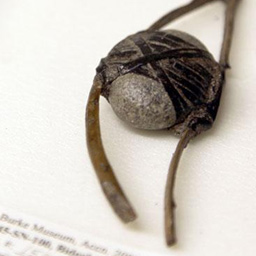Questions & Answers
What types of objects can the Burke Museum identify?
The Burke Museum specializes in objects and specimens from the Pacific Northwest.
Please note: We do not currently have an archaeologist specializing in the Southwest or Mesoamerica on staff. However, we are happy to get you in contact with specialists who can help.
What if I want my artifact authenticated or appraised?
The Burke Museum does not provide written certificates of authenticity or valuation (appraisals), nor opinions on the monetary value of objects for the general public. The public is welcome to contact the American Society of Appraisers, the Appraisers Association of America or the International Society of Appraisers for assistance.
What if I don't have an artifact but am concerned about a site?
If the site you are concerned about is on your property there are a few things you should do. First, limit impacts to the site. Don’t call attention to the site or tell too many people about it. This decreases the chance of looting at the site.
If it is an archaeological site, report it to the Washington State Department of Archaeology and Historic Preservation (DAHP). The site can then be recorded, with the landowner’s permission, and will add to the general archaeological knowledge about our region. Be sure to inquire about incentives such as tax breaks that are available to land owners. For more information about protecting your site see the information on site stewardship provided by the DAHP.
If the site you are concerned about is not on your property, please contact us and we can help you communicate your concerns to the appropriate legal official. State, federal, and tribal properties for the most part already have people working to protect sites on their property. However, they are often in charge of large regions and thus always appreciate it when the public aids in site stewardship. If you believe that an archaeological site on private property is being destroyed it is appropriate to communicate this information to the DAHP as soon as possible.
What do I do if I find an archaeological artifact on property that I do not own?
If you happen to come across an artifact on a property other than your own you should leave the artifact where it is. It is illegal to remove artifacts from land you do not own, both public and private. We recommend that if you have a camera handy that you photograph the object in place and the area around it. If possible, take a GPS coordinate or draw a detailed map of where the artifact can be found. Then contact the Burke Museum or the Washington State Department of Archaeology and Historic Preservation to report your find.
If you found this artifact on State, Tribal, or Federal lands you should contact the land manager and ask to speak to a cultural resource specialist. If you are confused about whom the appropriate land management agency might be the Burke Museum is happy to help you locate this information. It is also appropriate to contact the Washington State Department of Archaeology and Historic Preservation to report your find. If you find an artifact on private property that you do not own you should inform the landowner. Your find may contribute greatly to our knowledge of the region!
What do I do if I find human remains?
If you inadvertently come across human remains on your property or elsewhere, stop your activities in the area immediately. It is against the law to knowingly disturb a human burial.
The Burke Museum is happy to help facilitate the transfer of human remains to the appropriate Native American Tribe, or provide guidance on this process. However, there are both federal and state laws that govern the recovery of human remains. For this reason if you find human remains of any kind in Washington State, you are required by law to notify the county coroner and local law enforcement by calling 911. This is a necessary step in order to allow the medical examiner to determine whether or not they are human, and whether or not they are Native American. The discovery of human remains is first treated as a crime scene in order to rule out any recent criminal activities.
There are a number of laws in place that protect human burials. On public property (including federal and tribal land) the Native American Graves Protection and Repatriation Act (NAGPRA) provides guidelines for protecting Native American graves. On state and private lands, the Washington State Indian Graves and Records Act makes it is a felony to knowingly disturb an Indian grave.
If you have any questions about human remains please do not hesitate to contact the Archaeology NAGPRA Collections Assistant, Glenys Ong, at 206.685.3849.

Reach out to your local Tribe
We encourage you to continue your learning of Native American cultures by reaching out to your local Tribe for more resources.
